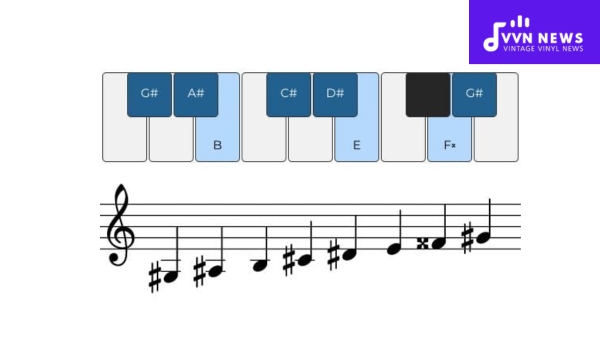The world of music is as vast and intriguing as the universe itself, with every note and scale offering a unique sense of beauty and resonance.
One such captivating tonal gem is the G sharp harmonic minor scale. This enigmatic musical scale holds an appeal that can bewitch a listener with its melodious charm and mystic allure.
Embarking on the journey to master this minor scale can be an enlightening expedition for any musician – professional or hobbyist alike.
Let’s set our sights on the mesmerizing world of music theory, focusing specifically on the foundations, structure, and usage scenarios of this exquisite G sharp harmonic minor scale.
Together, let’s unravel its myriad mystiques and decode its enchanting symphony!
Interval Structure of G Sharp Harmonic Minor Scale
The G sharp harmonic minor scale, like all harmonic minor scales, has a distinctive interval sequence that sets it apart from its relatives – major scales and natural minor scales.
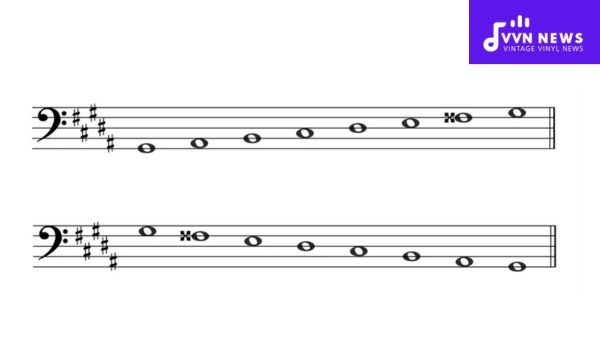
This unique sequence contains a mix of tones (whole steps), semitones (half steps), and an augmented second.
The specific pattern of intervals in the G sharp harmonic minor scale is:
- Tone (from G# to A#)
- Semitone (from A# to B)
- Tone (from B to C#)
- Tone (from C# to D#)
- Semitone (from D# to E)
- Augmented 2nd (from E to G#)
- Tone (from G# back to the octave)
This exotic concoction of interval steps gives the scale its distinguishing appeal and mystery.
Each progression adds up to build a symphony that can be truly bewitching for both performers and listeners.
The Harmonic Minor Scale Formula
Taking a closer look at the harmonic minor scale, it becomes evident that its construction is based on the composition of the natural minor scale.
The vital distinction lies in the reshaping of the 7th degree, which is sharpened.
This seemingly minor shift has a substantial impact on the nature of the scale, ushering in an enchanting blend of melodious charm and melancholy. As such, it can add depth and emotion to any composition.
To further break it down, here’s how it looks in tone (T) and semitone (S) intervals: T – S – T – T – S – T+1/2 – S.
This means two successive tones are followed by a semitone, then two subsequent tones followed by a leap of three half steps or one and a half tone before ending with a semitone.
Hence, if you’re on the quest for an exquisite sound to enhance your musical piece or melodic line improvisations, give this G sharp harmonic minor scale a whirl.
Degrees defining G sharp Harmonic Minor
The G sharp Harmonic Minor scale is known for its distinguished character, achieved by the melodious progression of seven unique degrees:
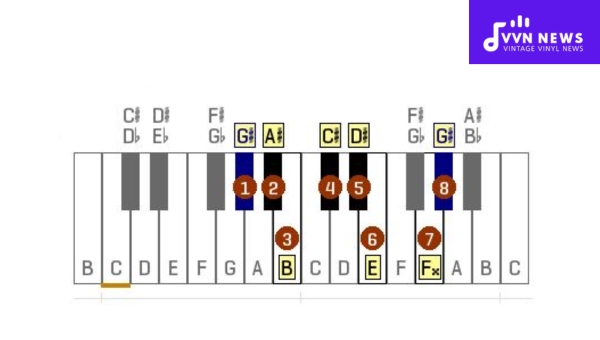
- First degree – G#: As the root note, it forms the basis of the scale.
- Second degree – A#: This note builds on the root creating a minor second interval.
- Third degree – B: Here, we shift from a minor second to a minor third, adding depth to the sound.
- Fourth degree – C#: Transitioning to perfect fourth creates a balance within the scale.
- Fifth degree – D#: The fifth progression takes us to the perfect fifth, this note provides harmony with our root (G#).
- Sixth degree – E: From perfect fifth to minor sixth, further lending profundity and emotion in sound.
- Seventh degree – Fx(F double sharp): Finally, we have an unusual entity called Fx (F double-sharp). It’s effectively a G note in other scales but named Fx here due to music theory conventions. Thus creating an augmented second interval from 6th degree E.
These degrees give G sharp harmonic minor scale its resonant tonality and invigorating character, offering countless opportunities for musical exploration and creativity.
Modes related to the G sharp Harmonic Minor scale
There are seven distinct modes associated with the G sharp Harmonic Minor scale, each playing a pivotal role in shaping your musical piece’s trajectory.
The variety of these modes provides musicians a broad palette to choose from, inviting diverse melodic possibilities into the composition.
Aeolian #7
The first mode we’ll explore is the Aeolian #7. This particular mode offers a uniquely enchanting resonance due to its structure, which retains the minor quality of the original scale but possesses an augmented 7th.
Many musicians and composers frequently utilize this mode to give their compositions a melodic twist, by infusing those traditionally melancholic minor elements with this unexpectedly heightened seventh note.
Locrian #6
Next in line is the Locrian #6 mode derived from our G sharp harmonic minor scale.
Here’s where things get a little spicy, as, unlike other modes of this scale, Locrian #6 encapsulates a unique combination of minor and diminished elements, with an augmented understanding sixth note thrown into the mix.
It’s one of those rare musical treasures that inspire incredibly diverse and artistically captivating creations.
Ionian #5
Reminiscent of the iconic major scale, Ionian#5 manifesto showcases yet another intriguing variant.
Having a peculiar deviation in its perfect fifth – which is now raised a half-step – Ionian#5 smoothly delivers an exotic augmentation that defines its entire character.
Altered Dorian
Drawing influences from both Dorian and Phrygian modal scales, Altered Dorian truly stands out from its siblings.
It strays away from Dorian’s traditionally raised 6th note, replacing it instead with a flattened variant.
This distinctive feature makes it an enticing choice for musicians seeking to experiment with darker hues in their compositions.
Phrygian Dominant
Also known as the Spanish Gypsy Scale or Flamenco Scale, the Phrygian Dominant embodies exoticness at its best.
Resonating with potent charm through its flattened ninth and just major third intervals, it enthralls music admirers universally with powerful usage in flamenco music.
Lydian #2
Pulling you from the familiar landscape of the Lydian mode, Lydian#2 dramatically raises the second note.
This decisive alteration breathes into this mode a unique aura of intrigue and experimentation.
Super Locrian 7
Rounding off our harmonic minor modal exploration with Super Locrian 7, a supreme embodiment of experimental artistry in music.
Sporting a double-flattened seventh note combined with an otherwise basic diminished arpeggio structure, it’s indeed a choice for musicians not fearing to venture into bold musical territories.
Techniques for G Sharp Harmonic Minor on Piano and Guitar
Delving into any musical scale acknowledges the significance of familiarizing oneself with the related techniques, more so in a versatile instrument such as the piano or guitar.
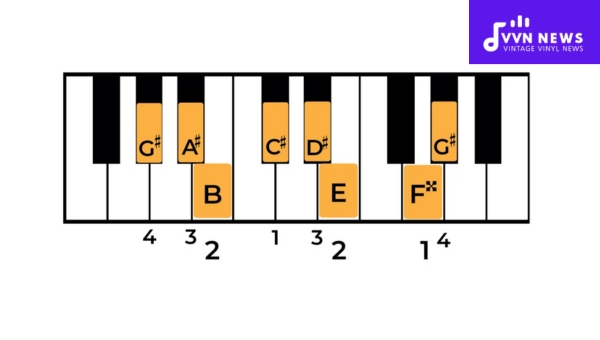
With a focus on the G sharp harmonic minor scale, let’s unveil some techniques for playing this intriguing scale.
Techniques for G Harmonic Minor on Piano
The first step toward mastering the G sharp harmonic minor scale on piano is to get familiar with the keys. Step onto your musical journey with the notes: G#, A#, B, C#, D#, E, and G.
- Start from the G# key. This will be your root note.
- Next, move up a whole step to A#.
- Follow with a half step to B.
- Continue with a whole step to C# and subsequently another whole step to D#.
- Move up only a half step this time to E.
- With an unusual leap of one and a half steps, you will reach your G which emerges as the 7th note of this scale.
- Finally, end at G#, rounding off the entire set of distinctive notes in your composition.
Techniques for G Harmonic Minor on Guitar
When it comes to the fretboard layout for the G sharp harmonic minor scale on the guitar, having basics down pat proves vital.
- The first note here is G#, which you can find at the 4th fret of the Low E string (6th string).
- Take one full-tone leap up (2 steps) and press down A# found on the 6th fret of the Low E string.
- The half-step journey leads to B playing at the 7th fret on the same string.
- Skip one fret (a full tone) landing on C# -9th fret of Low E or alternatively 4th fret of A string (5th).
- Another full-tone jump gets us D# at 6th fret A or 11th fret Low E.
- Here comes the trickier part; you pluck E following just a half-step from the previous note -7th fret A or 12th Low E.
- Although characteristic of harmonic minor, crown the sequence with an “augmented 2nd” or “minor 3rd” jump( 3 frets) thus picking G -10th fret A or alternatively 5th fret D String(4th).
- Lastly, wrap it up where you began; on the root note, G#.
This description serves as just one position to play G# Harmonic Minor on guitar. Broadening your skill set involves learning it all across the fretboard in various positions and patterns.
Investing time in repetition will build up muscle memory, go a long way in helping you navigate across strings with ease, and instinctively give you a shape to any new scale learned!
Also Read: How To Transpose Into The Tenor Clef? [Mastering In Notation]
The Key Signature for G Sharp Harmonic Minor
The G sharp harmonic minor scale, like other scales within the musical realm, follows a distinctive pattern.
It is composed of the following notes: G# (A flat), A#, B#, C#, D#, E, G#. Therefore, the key signature of G Sharp Harmonic Minor contains five sharps – F#, C#, G#, D#, and A#.
This gives the scale a unique blend of intervals that offer its notable tonality.
To play this on your instrument, be prepared to shuffle your fingers across keys or frets that are often sharp!
Mastering this unusual but intriguing scale could open a myriad of melodic possibilities for your compositions in music.
Also Read: A Guide Transposing Into The Alto C [Navigate Music Transposition]
G Harmonic Minor’s representation in various clefs?
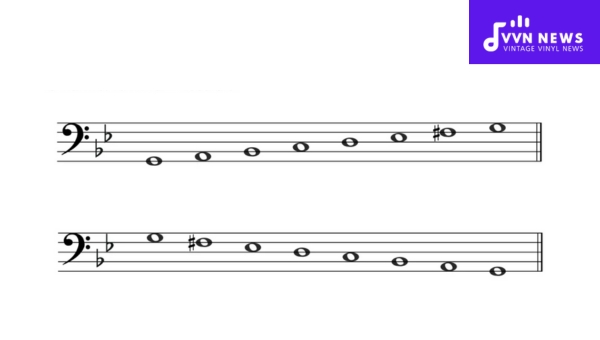
In any form of music, a ‘clef’ plays an instrumental role. It remains a pivotal notation denoting the pitch of the written notes and ensures accurate musical interpretations.
Let’s see how our G sharp harmonic minor scale manifests itself across different clefs.
Treble Clef
The treble clef (also known as the G clef) signifies that the second line from the bottom (where the curl forms) represents the note G.
In our treasured G sharp harmonic minor scale, starting from G#, you will find these notes following: G# A# B C# D# E Fx. (“Fx,” in music, symbolizing a doubly sharp F).
Bass Clef
Translating our scale to a bass clef (or F clef since it encapsulates the F note on its second top line), it still reads as: G# A# B C# D# E Fx.
While visually distinct on your sheet music due to its lower pitch representation, the actual notes remain consistent.
Alto & Tenor Clefs
If we cast an eye on fixed “C” clefs like alto and tenor, ladies and gentlemen, meet your new variant of G Sharp Harmonic Minor: G# A# B C# D# E Fx.
Recognizing this pattern regardless of clefs will help to enrich your versatile musicianship.
This magical experience of crafting harmony will soon become a part of your innate persona as a musician, resulting in more nuanced and enriched compositions.
Chords Derived from G Sharp Harmonic Minor
In the realm of chords, the G Sharp Harmonic Minor allows us to construct a fascinating array.
The chords that can be formulated using this scale include both major and minor harmonies. Below are the seven primary chords:
- G# minor/Major triad chord
- A# diminished triad
- B augmented triad
- C# minor chord
- D# Major triad chord
- E# diminished triad
- F## Major/Major Seventh
By experimenting with these various cordial treasures, you’re essentially creating myriad musical compositions resorting to the charm of the G Sharp Harmonic Minor scale alone!
Also Read: E Major Triad [Master This Staple Of Music Composition]
FAQs
What is the G Sharp Harmonic Minor Scale?
This music scale is a minor scale variant where the seventh note is raised by half a step, creating an augmented second interval between the sixth and seventh notes.
Does the G Sharp Harmonic Minor Scale have a unique sound?
Yes, it does. The raised seventh gives this scale a distinctive, somewhat ‘exotic’ melodic flavor that sets it apart from natural minor scales.
On which instruments can I play the G Sharp Harmonic Minor Scale?
This scale can be played on almost any musical instrument, including the piano, guitar, violin, flute etc.
Is it easy to learn the G Sharp Harmonic Minor Scale?
It all depends on your previous musical knowledge and how much time you can dedicate to practice. Learning any new scale requires patience and persistent practice.
Are there certain types of songs where I might hear this G Sharp Harmonic Minor Scale being used?
Yes. The distinctive sounds of this scale make it popular in various genres including jazz, pop, classical music as well as numerous styles of world music.
Also Read: F Sharp Major Triad [Enhance Your Musical Compositions]
Conclusion
Mastering the intriguing realm of the G sharp harmonic minor scale offers vast cinematic possibilities and expressive hues for aspiring musicians. With its exotic undertones and bewitching cadences, this harmonic minor is sure to enrich your musical repertoire significantly.
Remember, like any other scale proficiency, it requires consistent practice and a certain familiarity with descending and ascending note patterns.
Use this guide as your mainstay reference for appreciating the G sharp harmonic minor scale – from its theoretical underpinnings to practical application across instruments.
